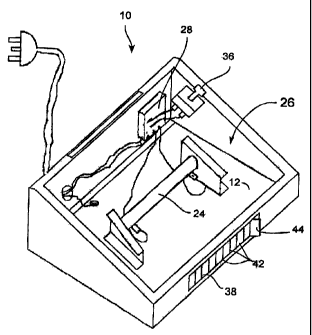Some of the information on this Web page has been provided by external sources. The Government of Canada is not responsible for the accuracy, reliability or currency of the information supplied by external sources. Users wishing to rely upon this information should consult directly with the source of the information. Content provided by external sources is not subject to official languages, privacy and accessibility requirements.
Any discrepancies in the text and image of the Claims and Abstract are due to differing posting times. Text of the Claims and Abstract are posted:
| (12) Patent: | (11) CA 2455199 |
|---|---|
| (54) English Title: | HEATING FOOT STOOL |
| (54) French Title: | REPOSE-PIED CHAUFFANT |
| Status: | Deemed expired |
| (51) International Patent Classification (IPC): |
|
|---|---|
| (72) Inventors : |
|
| (73) Owners : |
|
| (71) Applicants : |
|
| (74) Agent: | NA |
| (74) Associate agent: | NA |
| (45) Issued: | 2005-08-02 |
| (22) Filed Date: | 2004-02-23 |
| (41) Open to Public Inspection: | 2005-05-26 |
| Examination requested: | 2004-03-23 |
| Availability of licence: | N/A |
| (25) Language of filing: | English |
| Patent Cooperation Treaty (PCT): | No |
|---|
| (30) Application Priority Data: | ||||||
|---|---|---|---|---|---|---|
|
A heating footstool having a hollow casing having an inclined top wall, the inclined top wall being angled relative to a ground surface so as to allow the feet of an intended user to ergonomically rest thereupon and a heating means mounted within the hollow casing for heating the inclined top.
Un repose-pied chauffant ayant un boîtier creux ayant une paroi supérieure inclinée, la paroi supérieure inclinée étant inclinée par rapport à la surface du sol afin de permettre aux pieds d'un utilisateur de reposer de façon ergonomique sur ledit repose-pied et un dispositif de chauffage monté dans le boîtier creux pour le chauffage de la partie supérieure inclinée.
Note: Claims are shown in the official language in which they were submitted.
Note: Descriptions are shown in the official language in which they were submitted.

For a clearer understanding of the status of the application/patent presented on this page, the site Disclaimer , as well as the definitions for Patent , Administrative Status , Maintenance Fee and Payment History should be consulted.
| Title | Date |
|---|---|
| Forecasted Issue Date | 2005-08-02 |
| (22) Filed | 2004-02-23 |
| Examination Requested | 2004-03-23 |
| (41) Open to Public Inspection | 2005-05-26 |
| (45) Issued | 2005-08-02 |
| Deemed Expired | 2016-02-23 |
There is no abandonment history.
| Fee Type | Anniversary Year | Due Date | Amount Paid | Paid Date |
|---|---|---|---|---|
| Application Fee | $200.00 | 2004-02-23 | ||
| Request for Examination | $400.00 | 2004-03-23 | ||
| Final Fee | $150.00 | 2005-04-08 | ||
| Maintenance Fee - Patent - New Act | 2 | 2006-02-23 | $50.00 | 2006-01-13 |
| Maintenance Fee - Patent - New Act | 3 | 2007-02-23 | $50.00 | 2007-01-08 |
| Maintenance Fee - Patent - New Act | 4 | 2008-02-25 | $50.00 | 2008-01-17 |
| Maintenance Fee - Patent - New Act | 5 | 2009-02-23 | $100.00 | 2009-01-05 |
| Maintenance Fee - Patent - New Act | 6 | 2010-02-23 | $100.00 | 2010-01-14 |
| Maintenance Fee - Patent - New Act | 7 | 2011-02-23 | $100.00 | 2011-02-14 |
| Maintenance Fee - Patent - New Act | 8 | 2012-02-23 | $100.00 | 2011-12-15 |
| Registration of a document - section 124 | $100.00 | 2012-01-20 | ||
| Maintenance Fee - Patent - New Act | 9 | 2013-02-25 | $100.00 | 2013-01-14 |
| Maintenance Fee - Patent - New Act | 10 | 2014-02-24 | $125.00 | 2014-01-17 |
Note: Records showing the ownership history in alphabetical order.
| Current Owners on Record |
|---|
| FOURNIER, BERNARD |
| LEMIEUX, GISELE |
| Past Owners on Record |
|---|
| None |